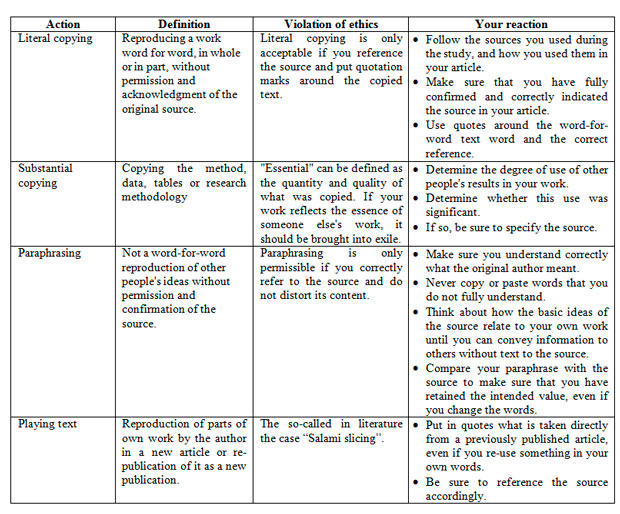Plagiarism policy
One of the most common types of violation of publication rules is plagiarism - when one author consciously uses someone else's work without permission, credit or confirmation. Plagiarism takes many forms: from literal copying to paraphrasing someone else's work and can include words and phrases, data and ideas.
Plagiarism has different levels of gravity depending on:
- How many borrowings - several lines, paragraphs, pages, full article?
- What was copied - the results, methods or introductory section?
However, when analyzing plagiarism, one must understand that each author is interested in using the results of his work, in citing them, and also the author himself should use the results of other authors. Therefore, it is necessary to distinguish plagiarism from the use of results.
Cases of reusing the results of their own and others' works

«Salami slicing»
The publication of a study that could be formed into one meaningful article, in several different articles, is called "salami publication" or " salami slicing".
Unlike a duplicated publication that includes the presentation of accurate data in two or more publications, cutting salami involves breaking up or dividing a large study into two or more publications. These segments are called "slices" of the study.
As a rule, if the "slices" of the divided study share the same hypotheses, population, and methods, this is an unacceptable practice. The same "slice" should never be published more than once.
Cutting salami can lead to a distortion of literature, leading unsuspecting readers to the fact that the data presented in each piece of salami (i.e. a journal article) are derived from independent research. This not only skews the "scientific database," but also creates a repetition that takes away the readers time, as well as the time of editors and reviewers who must process each article separately. Also, it unfairly inflates the list of publications and quotes by the author.
There are cases when the results of major studies cannot be published simultaneously since they are aimed at solving various and ambiguous questions with multiple and unrelated goals. In these cases, it is legitimate to describe important research results separately. However, each article should clearly define its hypothesis and be presented in the form of one of the sections of a much larger study.
Most journals require that authors who knew or suspected that the manuscripts placed for publication are fragmented data should disclose this information and attach any other documents (published or unpublished) that may be part of the manuscript in question.
To avoid cases of "salami slicing", it is necessary:
- Avoid improperly dividing data from one study into two or more articles.
- When submitting the manuscript, be transparent. Send copies of any documents closely related to the manuscript in question.
- This includes any published, recently submitted or already accepted for publication.
Multiple, redundant or parallel publication
As a rule, the author should not publish articles describing practically the same research in more than one journal. Simultaneous transmission of the same manuscript to several magazines is unethical behavior and is unacceptable.
In general, the author should not submit a manuscript of an article that was previously published in another journal, except in the form of an abstract, part of a published lecture or in the form of an electronic preprint.
The publication of certain types of articles (for example, manuals, translations) in several journals is sometimes justified under certain conditions. The authors and editors of the relevant journals must agree with the secondary publication, which should reflect the data and interpretation of the primary document. The main link should be listed in the secondary publication.
https://journals.qmu.ac.uk/api/depo-10k/https://ois.unsa.ba/slot-deposit-pulsa/http://103.165.243.97/doc/git/https://www.chiesadellarte.org/https://www.rollingcarbon.org/https://www.savebugomaforest.org/https://www.sigmaslot-profil.com/https://www.doxycycline365.com/https://thailottonew.site/https://hipnose.in/https://tennishope.orghttps://serenityprime.net/https://revista.farol.edu.br/uploads/pt2/https://civitic.indoamerica.edu.ec/wp-includes/pasarantogel2/https://journals.uol.edu.pk/classes/pasarantogel2/http://snabm.unim.ac.id/api/http://snabm.unim.ac.id/classes/slot-luar-negeri/http://103.165.243.97/doc/unsign/akun-pro-platinum/http://103.165.243.97/doc/word/mposlot/https://352spb.edusite.ru/slot-depo-10k/https://bundamediagrup.co.id/depo10k/https://loa.tsipil-uii.ac.id/sg-gacor/http://snabm.unim.ac.id/depo-10k/http://snabm.unim.ac.id/lib/slot-maxwin/http://103.165.243.97/doc/luar-negeri/http://103.165.243.97/doc/sign/slot-thailand/http://103.165.243.97/doc/before_tte/zeus-slot/https://appv2.tanahlautkab.go.id/doc/mpo/https://www.chuka.ac.ke/gates-of-olympus-1000/https://appv2.tanahlautkab.go.id/doc/unsign/http://103.165.243.97/doc/kamboja/http://mysimpeg.gowakab.go.id/mysimpeg/bangkomplit/http://mysimpeg.gowakab.go.id/toto/http://mysimpeg.gowakab.go.id/mysimpeg/maxwin/https://jurnal.jsa.ikippgriptk.ac.id/public/luar/https://www.unjc.cu/sweet-bonanza/http://103.165.243.97/doc/dana/https://fk.ulm.ac.id/wp-content/uploads/https://fk.ulm.ac.id/wp-content/fonts/https://ppid.cimahikota.go.id/infomugi/slot-luar-negeri/http://103.165.243.97/doc/cth/https://ppid.cimahikota.go.id/assets/maxwin-slot/https://ijatr.polban.ac.id/docs/https://loa.tsipil-uii.ac.id/data/thailand/https://loa.tsipil-uii.ac.id/scatter-hitam/https://ijatr.polban.ac.id/toto/https://ppid.cimahikota.go.id/infomugi/https://ppid.cimahikota.go.id/image/slot-gacor-hari-ini/https://mpp.bandung.go.id/mpo/https://mpp.bandung.go.id/assets/css/https://mpp.bandung.go.id/display/nexus/https://simba.cilacapkab.go.id/simba_project/maxwin-slot/https://simba.cilacapkab.go.id/simba_project/sbobet88/https://simba.cilacapkab.go.id/idnslot/https://mpp.bandung.go.id/surat/idnslot/https://fk.ulm.ac.id/wp-content/thailand/https://rdsp.msp.gob.do/api/thailand/https://perijinan.blitarkota.go.id/assets/jp-gacor/https://revista.forumseguranca.org.br/https://perijinan.blitarkota.go.id/data/situs-toto/https://perijinan.blitarkota.go.id/assets2/https://mpp.bandung.go.id/attachments/https://mpp.bandung.go.id/images/https://mpp.bandung.go.id/assets/thailand/https://perijinan.blitarkota.go.id/data/toto-slot/https://simba.cilacapkab.go.id/db/toto-slot/https://simba.cilacapkab.go.id/vendor/https://perijinan.blitarkota.go.id/data/depo-10k/https://mpp.bandung.go.id/git/demo/https://mpp.bandung.go.id/api/jp-gacor/https://simba.cilacapkab.go.id/assets/depo-10k/https://simba.cilacapkab.go.id/api/demo/https://simba.cilacapkab.go.id/api/https://sim.stidar.ac.id/img/https://sim.stidar.ac.id/sweet-bonanza/https://sim.stidar.ac.id/slot-anti-rungkad/https://kuesioner.instidla.ac.id/akun-pro-platinum/https://lpm.instidla.ac.id/lucky-neko/https://ijabr.polban.ac.id/mpo/https://ijabr.polban.ac.id/idn/https://kuesioner.instidla.ac.id/wild-bandito/http://kwitansi.instidla.ac.id/demo-lucky-neko/https://perdami.or.id/wp-includes/zeus-slot/http://kwitansi.instidla.ac.id/slot-garansi-kekalahan/https://bundamediagrup.co.id/wp-includes/idn/http://103.165.243.97/doc/maxwin-slot/http://103.165.243.97/doc/sv388/https://bundamediagrup.co.id/akun/demo/https://bundamediagrup.co.id/wp-content/akun-pro-kamboja/https://ijabr.polban.ac.id/api/https://ijabr.polban.ac.id/-/pulsa/https://sipirus.sukabumikab.go.id/storage/uploads/jp-thailand/https://sipirus.sukabumikab.go.id/storage/uploads/-/sthai/https://sipirus.sukabumikab.go.id/storage/uploads/-/stoto/https://sipirus.sukabumikab.go.id/storage/uploads/server-kamboja/https://alwasilahlilhasanah.ac.id/starlight-princess-1000/https://www.remap.ugto.mx/pages/slot-luar-negeri-winrate-tertinggi/https://waper.serdangbedagaikab.go.id/public/images/qrcode/slot-dana/https://waper.serdangbedagaikab.go.id/public/images/qrcode/slot-deposit-pulsa/https://waper.serdangbedagaikab.go.id/storage/framework/http://103.165.243.97/doc/thailand/https://appv2.tanahlautkab.go.id/easy-win/https://kuesioner.instidla.ac.id/asset/http://kwitansi.instidla.ac.id/database/http://lms.instidla.ac.id/backup/https://lpm.instidla.ac.id/wp-includes/block-patterns/http://mutu.instidla.ac.id/app/https://sipirus.sukabumikab.go.id/storage/uploads/kantah/https://sipirus.sukabumikab.go.id/storage/uploads/slot-depo-10k/https://ijabr.polban.ac.id/classes/slot-gacor-gampang-menang/https://ijabr.polban.ac.id/registry/https://ijabr.polban.ac.id/locale/https://lpm.instidla.ac.id/wp-content/uploads/https://bakesbangpol.katingankab.go.id/uploads/pulsahttps://sipirus.sukabumikab.go.id/storage/uploads/pembahas/

